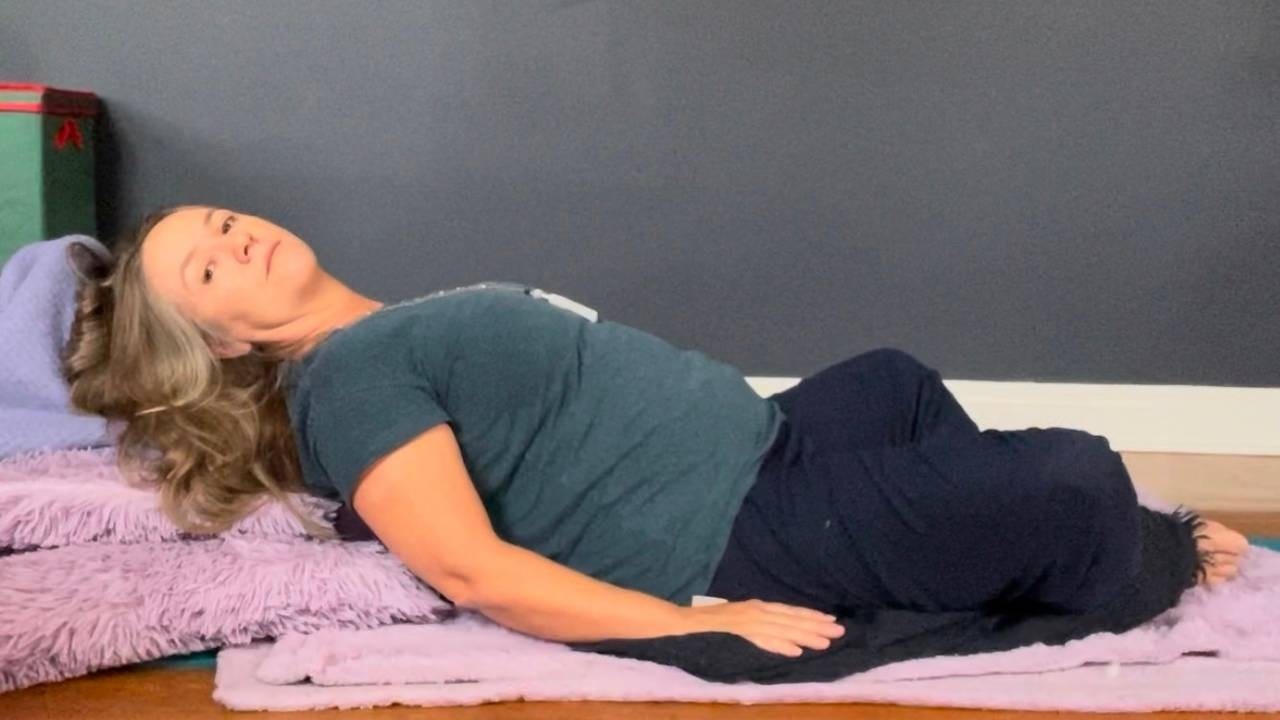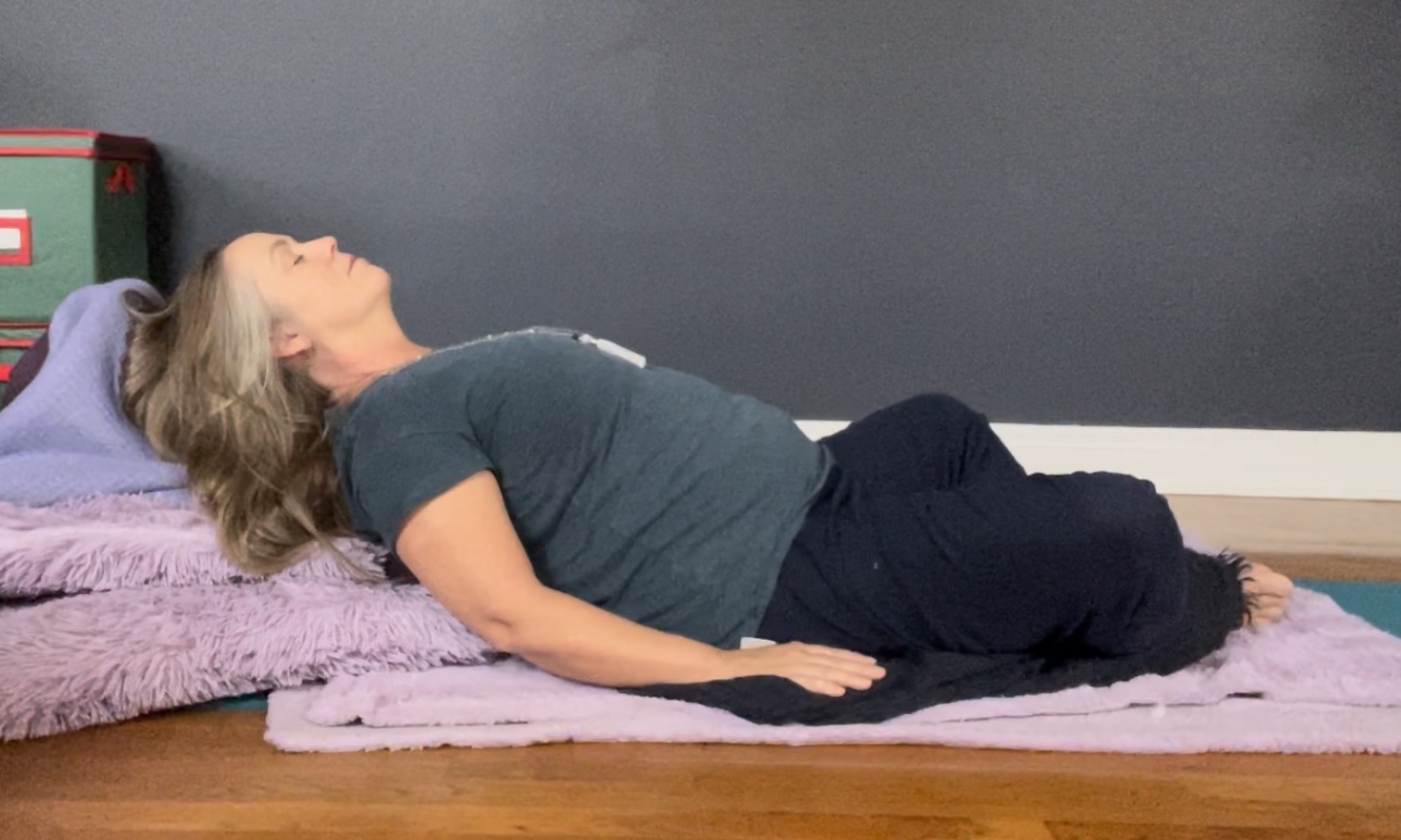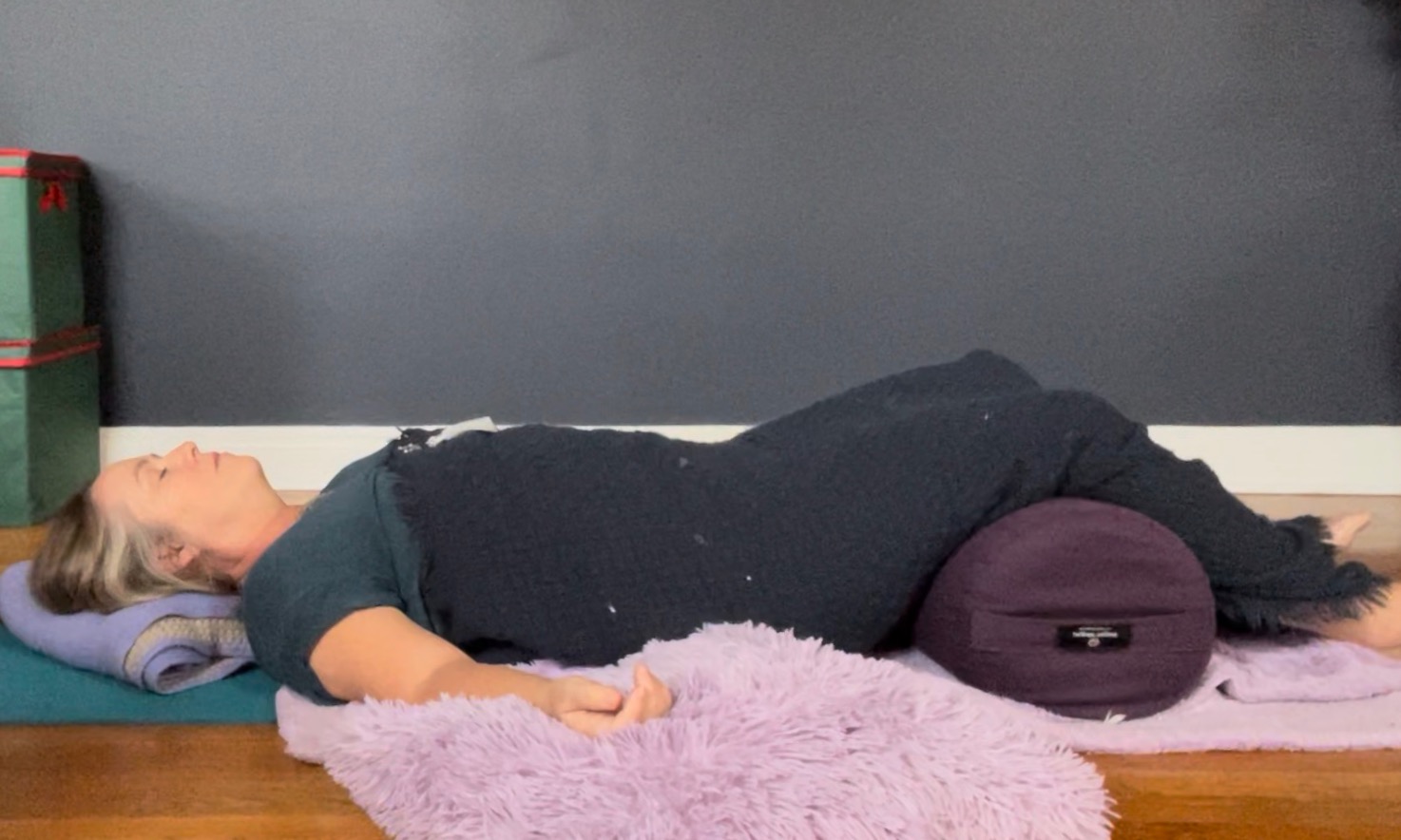
Invite in the new year with clarity, ease, and peace.
Register for our annual free workshop on New Year's Day.
This post was originally published on the blog: Yoga for Times of Change.
Restorative yoga can reduce mental clutter and physical tension, allowing access to your own insight. Self-inquiry is a way to befriend your inner wisdom. Begin your year with this practice to shed tension and make space for your intuition to flow in. While restorative yoga is very gentle, no body-based practice is right for everyone. This is not medical advice. Use discernment. And take a break from your devices or at least use “Do not disturb.”
Restorative Yoga Sequence for Welcoming the New Year
Before starting, gather the following:
- Something to write or draw with.
- Coffee or tea or something warm to drink.
- Couch cushions, pillows, and blankets to make your nest.
Your body temperature will naturally cool during the practice. The photos here don’t always show it, but I suggest draping an extra blanket over the top of your body to keep you warm.
1. Tune In to Your Practice
Take a few moments to tune in to your practice, either by chanting Om or in your own way. Send gratitude to your community. Take refuge in your practice. Restorative yoga is for releasing your nervous system rather than stretching. It is important that you are cozy and your joints are fully supported in each pose. As you settle into a pose, always prioritize your comfort over convenience.
2. Practice Supported Reclined Bound Angle Pose

Set up your props. Lean couch cushions on an angle to lie back on. Your knees will be apart and the soles of your feet will touch. Don’t pull your heels close to you. Let them be where they want to be naturally. Use a blanket to wrap over your ankles and tuck under your thighs. There should not be a stretching feeling at your inner thighs. If there is, use extra support under your outer legs.
Before you lie back, take a sip of your warm drink. Feel it traveling inward.
Another blanket can go over your belly and you can wrap your hands inside like a muff. Or you can put cushions under your wrists. In any case, let your elbows hang and your arms go.
Take your time lying back. Check that your legs, arms, head and neck are fully supported. Your chest should feel open and your lower back neutral. Cover up with another blanket on top. Take the extra time to feel cozy and supported by your props. You can set a timer for 5 or 10 minutes.
“Peace is this moment without judgement. This moment is the heart-space where everything that is is welcome.”
–Dorothy Hunt
3. Practice Joint Rotations
Roll to one side gently, roll your top wrist, shoulder, hip, and ankle a few times in each direction. Then turn over and do the same on the other side
4. Sit to Journal
How is your heart? Get quiet. Sip your tea or coffee. As a feeling arises, label it without judgment.
- Ask your heart, “How can I support you?”
- Ask your body, “How can I support you?”
- Ask your mind, “How can I support you?”
- What is the biggest gift in your life right now?
5. Practice Wrapped Crocodile Pose

Crocodile pose (Makarasana), is also known as Prone Savasana. Wrap a smooth long-folded blanket around your natural waist and lie on your belly. Make sure the blanket is positioned in between your ribs and pelvis. Support your head with your crossed hands or forearms. Breathe towards your belly. If you have eaten recently, try the pose without the blanket. Set a timer for 5 minutes. If your head is turned to the side, change directions halfway through.
Lying on your belly can help encourage your digestion of not just food but also experiences. As you metabolize your stress and stagnation, it is like wiping away dust from a windowpane. Clarity affords us the ability to see reality. Viveka is discrimination and clear vision. When you see clearly, the obstacles to love and truth are wiped away.
“You are under no obligation to be the same person you were five minutes ago.”
— Alan Watts
6. Practice Supported Wrapped Child’s Pose

After practicing Crocodile pose, you can keep the blanket around your belly and push back into Child’s Pose with your knees wide. Put your cushion under your head and belly, angling it up a little. Hug the cushion and let your arms be heavy. Tuck a blanket behind your knees if they are sensitive. Set a timer for 5 minutes.
7. Practice Standing Supported Forward Bend
Slowly move into a Standing Forward Bend, without raising your head. Use a prop under your hands, such a blocks or the seat of a chair, or you can even use a wall for support. Practice for 1 or 2 minutes.
8. Sit to Journal
Move right into sitting without bringing your head upright. Look back at the year with clear vision — viveka.
- What memory are you grateful for?
- Think of a struggle you had this year.
- What about that struggle makes you grateful?
- What gives you pleasure that you can expand this coming year?
9. Practice Side-Lying Savasana

Elevate your top lower leg on a cushion parallel to the ground. Support your head and top arm. Roll your body to face slightly towards the floor. Set a timer for 5 minutes. Roll to the other side for 5 more minutes.
10. Practice Wrapped Supine Savasana

This version of Supine Savasana is sometimes called Stonehenge pose. Put something supportive under your knees or your lower legs. Wrap a blanket around your body like a burrito to feel cozy and keep your knees from dropping out. Support your head and your whole neck with a folded blanket. Tuck the sides of your blanket in around your head and neck to keep it from dropping to the side. Place an extra pillow or folded blanket over your hip creases or lower belly. Set a timer for 20 minutes or more.
Relax and Unclench
Go through your body, inviting each part of you to relax and settle into gravity. If you like, you can listen to a guided body scan.
When you notice that you feel rigid, let go of your body a little bit. Unclench. You may need to intentionally go through and tighten your muscles to let them remember how to release. Most of us have been carrying a lot of fear this past year. Fear is inverse to intuition.
Float Along With Life's Ebbs and Flows
Imagine you are clinging to a riverbank. Let go. Trust that you’ll be carried along, through both rough and restful bends in the river. Life ebbs and flows. You can float with it or cling to the bank white-knuckled with resistance. Sigh and trust that you’ll be carried. There will be some circuitous sections of the river and some straight routes. The one thing we can count on is change. Float with it. You’re not alone in the river.
When your timer goes off, decide if you wish to stay longer. If not, yawn and stretch a bit and then ease to your side. Take plenty of time to rise.
“Action with an unclear mind is a circuitous route. Action with a clear mind is a straight route.”
—T. Krishnamacharya
11. Sit to Journal
Look forward with clear vision and meditate or write. You don’t need any more prompts. You are not the same person you were 5 minutes ago.
12. Close Your Practice, Remain Open
Chant “Om shanti shanti shanti” as a gesture of peace, or end in your own way. Throughout the year, refer back to your journal entries to remind yourself of the gifts in your life and where you want to expand pleasure. Make regular updates as you change. Continue to ask your heart, “How can I support you?”
Life expands and contracts, while your clear vision carries you along. Remember, everything that is, is welcome. As Dorothy Hunt reminds us:
“Peace is this moment without judgement…
Peace is this moment without thinking
that it should be some other way,
that you should feel some other thing,
that your life should unfold according to your plans.”
Read this post at Yoga for Times of Change.
FREE WORKSHOP
New Year's Day Yoga, Purpose,
& Pajamas
Settle into cozy support. You will move gently, breathe mindfully, and connect with your purpose for 2023. LIVE on Zoom 1-2pm EST. A replay will be provided to those who register.
REGISTER NOW
Kate Lynch (she/her) is the parent of an amazing atypical kid, an inclusive yoga and mindfulness coach, and an author. Kate began cultivating community in 2002. Since then she has shared the tools that help her find joy, healing, and calm in the face of self-doubt, pain, and anxiety. Her classes are welcoming, friendly, and intuitive, and they reflect her core values of empathy, integrity, equity, and respect. Her little neurodiverse family lives in a magical land called Brooklyn.
Stop Walking On Eggshells!
Gentle yoga to release your stress and shift your mindset about struggle.
If you get your buttons pushed often by other people's issues, you may be hypervigilant. You might feel it in your body as clenching, tension, or chronic pain.
You'll become more grounded in awareness of your body.

